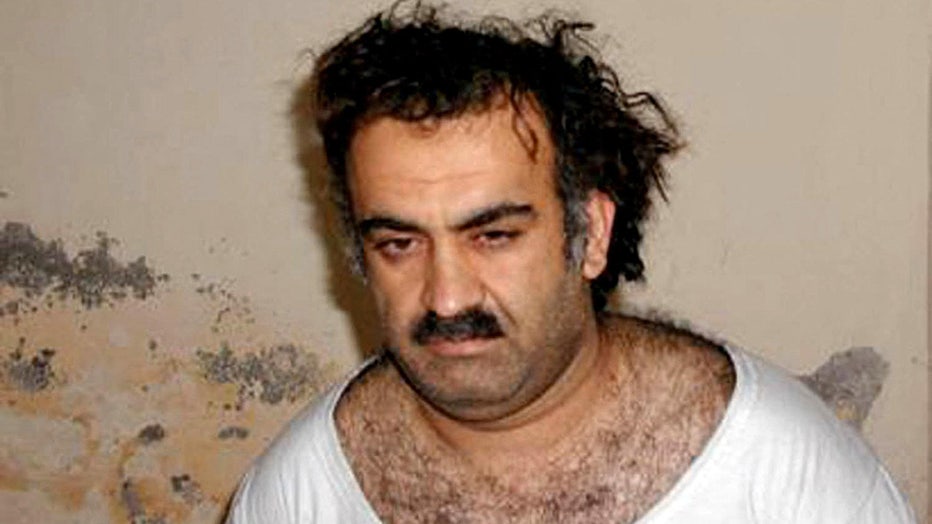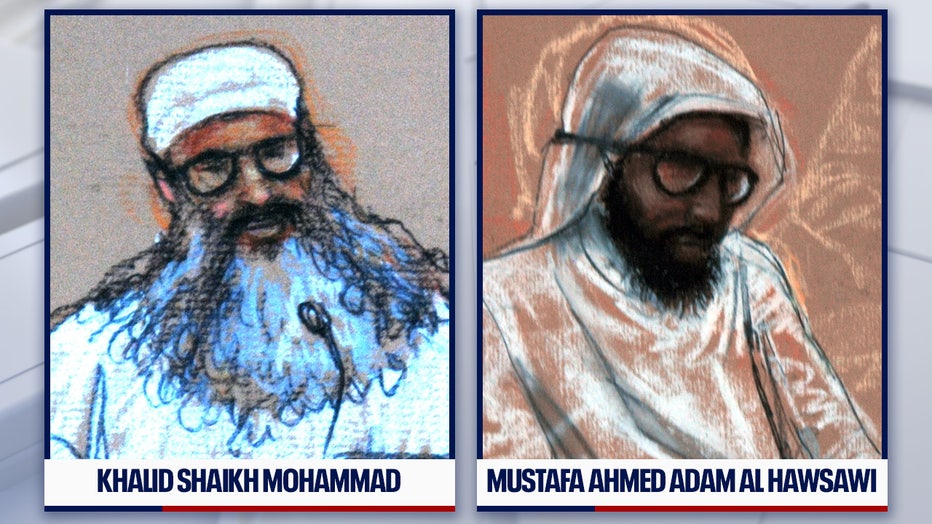9/11 defendants reach plea deal, reportedly avoid death penalty
The Department of Defense announced that plea deals have been reached for three men and their roles in the 9/11 hijackings.
The Convening Authority for Military Commissions said it has entered pretrial agreements with Khalid Shaikh Mohammad, Walid Muhammad Salih Mubarak Bin 'Attash, and Mustafa Ahmed Adam al Hawsawi.
However, the details of the plea agreement are not publicly available for the time being.
The New York Times, citing unidentified Pentagon officials, said the terms included the men’s longstanding condition that they be spared risk of the death penalty.
RELATED: Saudi Arabia and 9/11: New video revives questions about kingdom’s involvement
The three defendants, along with Ali Abdul Aziz Ali and Ramzi Bin al Shibh, were first charged and arraigned in June 2008. They were then charged and arraigned in May 2012 for their roles in the September 11 hijackings against the U.S.
Who are the defendants?
Khalid Shaikh Mohammed was a top al-Qaida official and deputy to Osama bin Laden, the mastermind of the Sept. 11, 2001, attacks. He was captured in 2003 and hauled away by intelligence agents from a hideout in Rawalpindi, Pakistan.

This U.S. government handout photo from March 1, 2003, shows Khalid Sheikh Mohammed, alleged organizer of the September 11, 2001, attacks, shortly after his capture. (AFP via Getty Images)
Mohammed, at a previous tribunal hearing, conceded in a written statement that he swore allegiance to Osama bin Laden, that he was on al-Qaida’s council and that he served as operational director for bin Laden for the organizing, planning, follow-up and execution of the Sept. 11 plot "from A to Z."
According to the statement, he also took credit for the 1993 bombing of the World Trade Center; an attempt to down U.S. jetliners using bombs hidden in shoes; the bombing of a nightclub in Indonesia; and plans for a second wave of attacks after the 2001 attacks targeting landmarks like the Sears Tower in Chicago and Manhattan’s Empire State Building.

Courtroom sketches drawn by artist Janet Hamlin in June, 2008. (Dept. of Defense)
RELATED: Tunnel to Towers Tower Climb honors first responders and military heroes
He also claimed credit for other planned attacks, including assassination attempts against then-President Bill Clinton in 1994 or 1995 and an assassination plot against Pope John Paul II at about the same time, the statement said.
Walid Muhammad Salih Mubarak Bin Attash and Mustafa Ahmed Adam al Hawsawi were also al-Qaida members.
Why has it taken this long to get a plea deal?
America’s attempt to bring the defendants to justice, in a legal sense, has taken much, much longer.
The difficulty in holding a trial for Mohammed and other Guantanamo prisoners is partly rooted in what the U.S. did with him after his 2003 capture.
Mohammed and his co-defendants were initially held in secret prisons abroad. Hungry for information that might lead to the capture of other al-Qaida figures, CIA operatives subjected them to enhanced interrogation techniques that were tantamount to torture, human rights groups say. Mohammed was waterboarded — made to feel that he was drowning — 183 times.
RELATED: Remains of 1,650th 9/11 victim have been identified
A Senate investigation later concluded the interrogations didn’t lead to any valuable intelligence. But it has sparked endless pretrial litigation over whether FBI reports on their statements can be used against them — a process not subject to speedy trial rules used in civilian courts.
The torture allegations led to concerns that the U.S. might have ruined its chance to put Mohammed on trial in a civilian court.
But in 2009, President Barack Obama’s administration decided to try, announcing that Mohammed would be transferred to New York City and put on trial at a federal court in Manhattan.
"Failure is not an option," Obama said.
But New York City balked at the cost of security and the move never came. Eventually, it was announced Mohammed would face a military tribunal. And then over a dozen years passed.
What was, and is, al-Qaida?
Born out of the 1980s war against the Soviet Union’s occupation of Afghanistan, the terror group al-Qaida under Osama bin Laden grew into a generational threat to America that culminated in its Sept. 11, 2001, attack that brought down the World Trade Center in New York.
Al-Qaida, or "the Base" in Arabic, organized as the Soviets pulled out of Afghanistan. Hoping to capitalize on the support the mujahedeen, or the "holy warriors," received during their war against Moscow, bin Laden formed al-Qaida and became its leader. The son of a construction magnate in Saudi Arabia, bin Laden also enjoyed familial wealth as well.
Biden says U.S. achieved its goals in Afghanistan: To bring Osama Bin Laden to the gates of hell
President Joe Biden on Thursday said the U.S. military mission in Afghanistan will conclude on Aug. 31, saying "speed is safety" as the United States seeks to end the nearly 20-year war. "We did not go to Afghanistan to nation build," Biden said in a speech to update his administration’s ongoing efforts to wind down the U.S. war in Afghanistan. "Afghan leaders have to come together and drive toward a future." Biden also amplified the justification of his decision to end U.S. military operations even as the Taliban make rapid advances in significant swaths of the country.
RELATED: Father of fallen NYPD officer who advocated for 9/11 compensation fund struck, killed by SUV
Ayman al-Zawahiri, an Egyptian who became leader after bin Laden’s death, has faded in prominence in recent years and is believed to be in poor health. Bin Laden’s son, Hamza, who became a leading figure inside al-Qaida, was later killed.
But al-Qaida’s prominence following Sept. 11 saw it gain affiliates across the Mideast. One became the Islamic State group, whose filmed beheadings and takeover of large parts of Iraq and Syria shocked the world.
What happened to Osama bin Laden?
Bin Laden was killed in Pakistan on May 2, 2011, in operation carried out by U.S. Navy SEALs after a nearly decade-long hunt.
The Associated Press contributed to this report. This story was reported from Los Angeles.

